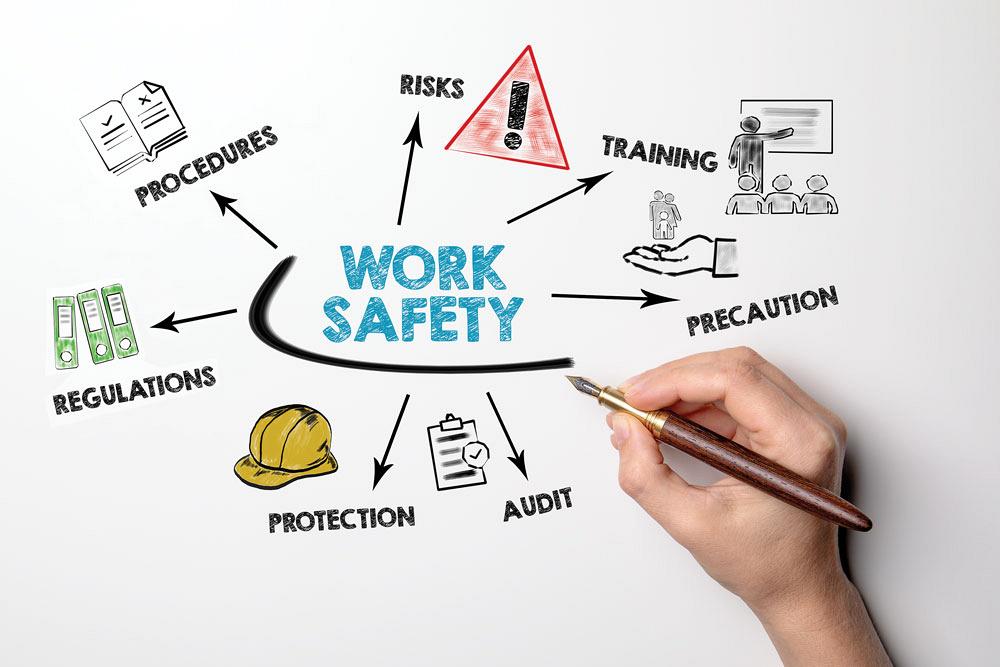- FMA
- The Fabricator
- FABTECH
- Canadian Metalworking
Building a safety-focused culture
Include workers in health and safety protocols, encourage communication
- May 9, 2022
Workplace health and safety is important in any industry, but the stakes are especially high in metal manufacturing shops.
How do you motivate everyone to be engaged, interested, and involved in keeping safe work practices top of mind? And what’s the best way to ensure safety procedures are communicated to everyone? Here are three important practices.
1. Have a Good Program
A good practice--and a legislative requirement in most Canadian jurisdictions--to keep your employees safe at work is to have a comprehensive, integrated, often-referenced health and safety program. This program should include all the elements required by the legislation, such as policies, workplace inspections, and other safety initiatives developed by the employer with involvement from employees, the health and safety committee or representative, and the union (if applicable). The program must be clearly communicated to employees, implemented throughout the organization, integrated into business practices, and evaluated on an ongoing basis.
Having all safety-related policies and procedures located in a central place where employees can access them will help encourage everyone in the workplace to read policies that may have changed recently or that affect a particular aspect of their work.
Underscore that safety is paramount in your workplace by ensuring that employees hear from the health and safety committee or their manager regularly, even if the updates are brief.
2. Provide the Right Training and Equipment
A reliable way to improve employee engagement with safety is to train staff effectively and promote a strong safety culture, beginning when new hires are onboarded.
Make training interactive. Studies have shown that the level of employee engagement in training is a key factor in an organization’s safety program effectiveness. Training that presents information but requires little active participation by the employee has minimal impact on reducing workplace incidents. Training that engages employees and involves hands-on practice in a realistic setting results in stronger retention of the material presented, which may lead to reduced workplace incidents.
Some topics to include in safety training and orientations are:
- Proper use of personal protective equipment.
- What to do in case of injury and during emergencies.
- The locations and contents of first aid kits and the names of personnel who are trained in first aid.
Training also must include task-specific information such as the safe operation of any machinery.
Communicating safe work practices doesn’t start and stop with a new hire either. Though a crucial element of the orientation process, it’s equally important to provide ongoing safety and refresher training to existing employees. Implementing these strategies into training and retraining on an ongoing basis helps everyone develop a safety-first attitude and helps them avoid becoming complacent.
3. Lead by Example and Welcome Feedback
Ensure that your comprehensive workplace health and safety program is referenced often by your management team and that it is easily accessible to all employees. This can help set the tone that the safety and well-being of employees are top priority.
Organize regular retraining sessions for managers and supervisors on conducting safety audits, workplace inspections, and incident investigations. Wherever possible, have them participate in new-hire safety orientations and lead safety toolbox talks. This demonstrates commitment to protecting workers and creating the safest possible workplace.
When new machines are introduced to the workplace, ensure all employees are trained on their proper use and are given enough time to thoroughly review the manual before attempting to operate them. The same goes for new chemicals or cleaning agents.
Establish similar procedures for hazardous products. Never leave room for assumptions that procedures for their use haven’t been updated. Always review the safety data sheet for the safe use, storage, and handling of a hazardous product.
It’s important to routinely check in with your employees to review safe work procedures.
If something isn’t working for them, see if there’s anything you can do to improve the process without sacrificing safety or introducing new hazards. When developing new safety procedures, be sure to focus on identifying the hazards at each step of the task to ensure the hazards are controlled. Include your employees in these discussions as they are the most familiar with the tasks. They may have additional feedback or suggestions to improve safety practices. This employee engagement in health and safety will help promote a positive workplace culture.
Encourage staff to speak up when they see unsafe work and risky behaviour and report any health and safety concerns. This reinforces the internal responsibility system where everyone has a role to play in looking out for each other and helping prevent work-related injuries and illnesses.
Communication and involvement are key to employee health and safety engagement. Focus groups, surveys, and interviews can provide insights on how to make training more effective. You also may learn what values guide and motivate employees on a day-to-day basis. Be sure to always follow up and acknowledge their feedback. While you may not be able to implement a change immediately, letting people know their voice is heard and stating the organization’s intentions to improve will continue to foster an environment of worker engagement and involvement.
Remember, there is no one-size-fits-all solution. Each workplace is unique in terms of tasks, needs, values, and culture. Taking the time to keep employees engaged in program development, interested in ongoing training, and involved with continuous improvement will help everyone keep safety top of mind.
This article was supplied by the Canadian Centre for Occupational Health and Safety (CCOHS), 135 Hunter St. East, Hamilton, Ont. L8N 1M5, 800-668-4284, www.ccohs.ca.
subscribe now


Keep up to date with the latest news, events, and technology for all things metal from our pair of monthly magazines written specifically for Canadian manufacturers!
Start Your Free Subscription- Industry Events
MME Saskatoon
- May 28, 2024
- Saskatoon, SK Canada
CME's Health & Safety Symposium for Manufacturers
- May 29, 2024
- Mississauga, ON Canada
DiPaolo Machine Tools Open House 2024
- June 4 - 5, 2024
- Mississauga, ON Canada
FABTECH Canada
- June 11 - 13, 2024
- Toronto, ON Canada
Zoller Open House & Technology Days 2024
- June 12 - 13, 2024
- Ann Arbor, MI





















